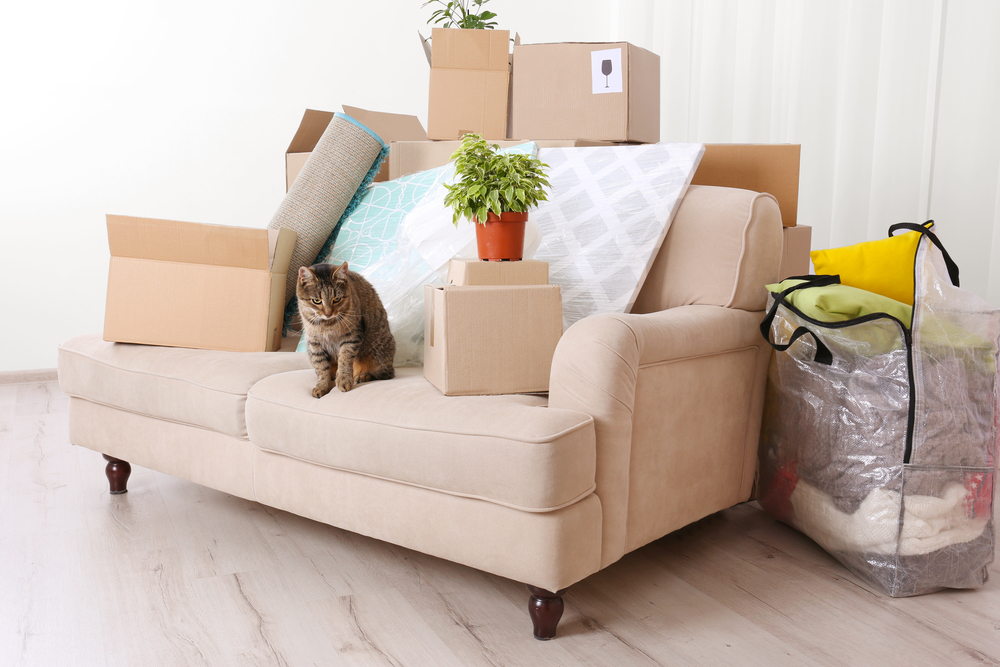The Ultimate Guide to Moving With Cats in 6 Steps

Moving soon? Get organized with our free moving checklist.
Preparing for your move can take many forms, particularly if you’re doing so with a pet.
Cats, for instance, are territorial animals. They typically dislike even a small change, let alone one as big as moving to a new home. Taking some simple steps can help improve their experience and help you feel at ease that you’re doing everything you can for your feline friend(s).
1. Figure out transportation logistics
Moving with cats across town will look different than moving them across the country will. As long as the drive isn’t more than a few hours long, you can simply transport your cat in a crate — your kitty should be fine without any bathroom breaks.
Longer moves will require more planning. Here’s how to prepare for a few common scenarios.
- Driving long distances with cats: If you have a long drive ahead of you and your cat, consider where they’ll go to the bathroom. Set up a large crate with portable litter boxes and food bowls — just remember to introduce your cat to the arrangement in advance. Spend plenty of time in the car with them in the weeks leading up to the move.
- Staying in hotels: For a multi-day trip, you may end up staying overnight in a hotel with your cat. There are plenty of cat-friendly hotels and motels all around the country, but it’s important to do your due diligence. Even if you find what seems like a pet-friendly hotel, call and ask if they allow cats as well as if they charge any additional fees.
- Flying with cats: If you’re moving internationally or need to fly to your new home, you can take your cat with you — but there are a few additional logistics to consider. First, you’ll need to find an airline that allows cats to travel in the cabin and purchase a carrier that fits their restrictions. (The Veterinary Centers of America recommends a soft-sided crate, which typically fits the easiest under plane seats.) Book tickets as early as possible, as many airlines limit the number of animals allowed per flight. You’ll need to arrange your pet’s vaccination records, a certificate of health, and potentially customs paperwork.
- Pet transportation companies: Employing a pet transportation company can take some of the complexities out of moving with cats. They take on some of the burden of making arrangements, such as completing paperwork and scheduling transportation. Some offer comprehensive door-to-door delivery — however, these services can be expensive, and you won’t be able to personally monitor and comfort your pet during travel. If you plan to use a pet shipping company, do plenty of research to select a licensed and experienced company with professional animal handlers. The International Pet and Animal Transportation Association is a good place to start, as it offers a database of reputable pet shipping companies.
2. Visit your veterinarian
You’ll undoubtedly be busy packing and readying your home in the weeks before your move. When moving with cats, there are a few pet-related tasks to add to your to-do list. Most importantly, you’ll want to schedule one last visit with your veterinarian, who will make sure your cat is up to date on all vaccines and healthy for travel. This visit is also an opportunity to ask for any medications (such as one for motion sickness) and get a copy of your cat’s file to provide to your new vet.
While you’re there, take advantage of their expertise. Ask any last-minute questions you have about traveling with your cat and getting them comfortable in a new home. Your vet may be able to provide tips for easing the transition, especially because they know your pet personally.
3. Acclimate your cat to the crate
Begin preparing your cat to spend time in the crate well before the trip. Start by leaving the crate out and open for your cat to explore. Once they’re comfortable around it, you can start feeding them inside the carrier. This will create a positive association with the crate, helping them feel comfortable and safe inside. Sprinkling some catnip in and around the crate can help, too.
You’ll also want your cat to get used to your vehicle. Start by sitting together in the car, with your cat in the crate, for a few minutes at a time — don’t even turn the car on at first. After a week or so of this, you can try turning on the engine, and when your cat is comfortable with that, try taking a short drive around the block. Building up to the trip slowly ensures your cat isn’t overly stressed or anxious in a car by moving day.

4. Get your cat supplies together
A few days before you move, pack up a bag with moving day essentials for your cat. Here’s what you should have readily accessible:
- Collar or harness with ID tags
- All your cat’s medication
- Water bottle and collapsible bowl
- Folder with vaccination records and certificate of health
- Puppy pads to line the carrier
- Paper towels and latex gloves to clean up accidents
- A few servings of your cat’s normal food
- A few of their favorite toys
- Portable litter box and extra litter, if needed
- Leash, if needed
5. Make a moving day plan
On moving day, sequester your cat in a quiet room with a litter box and water, and put a sign on the door alerting movers not to open it. When it’s time to hit the road, load your cat into their carrier, give them any medication they need, and securely fasten their collar or harness.
From here, you can travel as planned. Avoid opening your cat’s carrier unless totally necessary, as your cat may bolt if frightened. If you’re flying with your cat, be aware that you’ll have to take them out of their carrier in order to pass through security — keep a leash handy.
Once you arrive at your new home, place your cat in a room away from the action with their litter box, toys, food, and water. Again, put a sign on the door letting movers know not to open it. They’ll probably want to hide at first after you let them out of the crate, so consider leaving a few treats around the space to encourage them to explore.
Keep your kitty isolated in the designated room until the move is complete. You might contain them in one room for up to a few days depending on how well they react to the transition.
6. Settle into your (and their) new home
Every cat reacts differently to moving. Some will hide for a few days, while others might be up and exploring within a few hours. Both reactions are normal — just let your cat move at their own pace.
Even if your cat is typically allowed outdoors, the Veterinary Centers of America recommends keeping them inside for at least two weeks after moving. Cats will often try to return to their old homes, so if you do let them out, start with short outdoor excursions on a leash, and be sure they’re wearing an ID tag with your contact information.
As your cat slowly acclimates to their new space, there are a few other things you’ll need to do:
- Find a new veterinarian and schedule an initial visit.
- Update your cat’s microchip information.
- Register your cat with the local government, if necessary.
- If you live in an apartment or condo, register your pet with the management company and pay any associated fees.
These steps make bringing your kitty to a new home easier for everyone involved. With the right prep, the moving process will feel less like herding cats than it actually is — which, in this case, may involve some literal herding. Your cat’s next favorite sunning spot is waiting for them.
Moving soon? Get organized with our free moving checklist.
Internet and TV tips
Switching providers and don’t know where to start? We can help.













